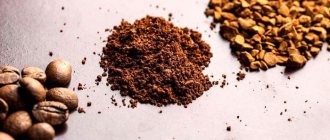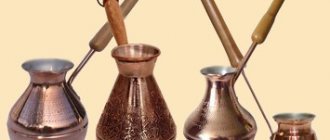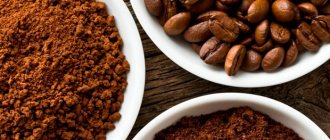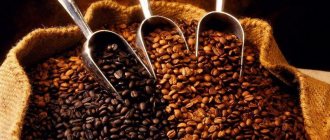Finding the perfect balance between the two components is always a painstaking, responsible, and interesting process. As in any other area, in coffee circles it is also important what and how to drink this drink correctly. After all, an unsuccessful mixture of varieties is the same as poor taste in clothes - well, who would like classic trousers and a top? Therefore, we consider product combination to be an extremely important issue. This article will introduce readers to the best coffee “friends” and also tell you what they serve with coffee.
It’s interesting that different countries also treat coffee differently. It is undoubtedly loved everywhere, as we already said, because this product is the second most popular in the world. Somewhere they prefer to drink it exclusively in its pure form, and all the additives from which cappuccino, latte and others are made are considered desserts. For example, in Italy you will not see city residents during the day or evening with a cup of mocha, frappe or the same cappuccino. They approve of these sweets only in the morning, and during the day they prefer pure Americano or doppio caffè espresso (double espresso). And the French really love fresh pastries with coffee; everyone knows their weakness for croissants and buns. But in distant India they love sweets, so they always have a lot of rolls, cakes with creams, and other desserts to accompany the drink of vivacity, which attract sweet tooths all over the world.
Every dessert has its own pros, but we'll introduce you to a list of foods that make the best coffee snacks.
Traditional Supplements
To make the taste softer or, conversely, sharper, classic black coffee is drunk with:
- Sugar - only ¼ tsp. per cup allows you to soften the taste and set off the natural bitterness. With proper nutrition (PN), you can use natural sweeteners - stevia, agave syrup.
- Milk, cream - they make the taste softer. The higher the fat content, the richer the bouquet of the drink.
- PP supporters are recommended to use soy or almond milk, which adds additional taste and aroma and does not require the addition of syrup.
- Spices and herbs. Carnation and vanilla radically change the bouquet. You can drink coffee with cinnamon and cardamom if you eat properly - these additives will add an interesting flavor to the usual taste, and will also prevent your blood pressure from rising too much.
- Honey is a natural sugar substitute that enriches the coffee taste. It is better not to add it to a drink, since when heated it loses its beneficial properties, but eat it as a snack, like a dessert. Honey is also allowed for PN, but only in small doses.
- Alcohol. You can add a couple of teaspoons of cognac, rum, brandy, liqueur. In a hot drink, the alcohol will evaporate, but will leave a rich aroma and aftertaste.
A cup of black coffee contains only 1-2 kcal, but a little milk and sugar raises its calorie content to 54 kcal. Therefore, in its pure form, the drink is even welcome in the PN system due to its stimulating effect and acceleration of metabolism. You need to be careful with additives.
- Don't miss: Coffee calories per cup
By the way, coffee shops serve water with espresso. This is no coincidence. A sip of clean water before drinking coffee helps cleanse your taste buds and better sense the bouquet. Also, espresso often makes you thirsty. The very strong drink is drunk in small sips, alternately with water, to tone down the bitterness.
Snacks - simple and satisfying
Often, without having time to have breakfast, we grab a sandwich on the run and wash it down with coffee. It's simple and delicious. Apparently, this is why it is increasingly served with toasts, canapés, and baskets at buffets.
Sandwiches with smoked meats are popular. White chicken meat or omelet are not inferior to them. And what can we say about cheese: different varieties leave their own aftertaste. By the way, diced cheese is also added directly to the cup.
Coffee can safely be called a universal drink. Its taste goes well with most foods. If guests suddenly arrive, brew them this wonderful drink, serve them your favorite coffee dessert or sandwich. Rest assured, they will be satisfied.
photo: depositphotos.com/Fieryphoenix
What desserts go well with coffee?
Coffee and sweets are a favorite combination of many fans of this drink. So, they go perfectly with espresso:
- meringue;
- chocolate;
- butter sausages;
- panna cotta;
- chocolate covered nuts.
At the PP you can also treat yourself to espresso with a slice of chocolate, but it is better to choose natural one with a cocoa bean content of 75%. By the way, this delicacy stimulates the production of serotonin, the pleasure hormone.
You can serve oriental coffee with:
- candied fruits;
- cane sugar candies;
- halva, Turkish delight, baklava;
- marshmallows and marshmallows - these are also allowed for those who are on a diet.
Surprisingly, caramel and marmalade are not recommended for coffee. On the other hand, if you like this combination, then why not.
In Russia and throughout Europe, coffee drinks with milk are popular - cappuccino, latte, macchiato. They are harmoniously complemented by pastries and desserts:
- croissants – together with espresso they make an excellent breakfast;
- brownie – emphasizes the coffee base, recommended for cappuccino;
- cheesecake - makes a good combination with the milky taste of latte;
- cookies – tender crackers are recommended for lattes and macchiatos, and rich curabier for cappuccino;
- cream desserts with butter, milk, cream, almond crumbs;
- pancakes and cookies made from oatmeal, bran and fiber are a great addition to keeping your figure.
Another popular addition to an invigorating drink is fruit. It is better for PP adherents to drink coffee with a slice of lemon, oranges, peaches, green apples, and kiwi. Grapefruit and pineapple actually have a fat-burning effect. Melon and watermelon are not recommended as they enhance the diuretic effect.
Scientific approach
It's simple: products are combined with each other if they have common aromatic components. Based on this fact, the developers of the Foodpairing platform created a program that searches for ideal flavor pairs. Using a gas chromatograph, they analyzed the aromas of more than 1,700 products, identified the dominant components in each, compiled a database and wrote combination algorithms, taking into account the texture of the products and the contrasts of basic tastes. The program for finding flavor combinations was created for chefs, but may be of interest to every coffee lover. And for industry professionals it is also useful.
Thus, in 2015, at the symposium of the American Specialty Coffee Association, an interesting report was made: how properly selected dishes help highlight the differences in coffee from different regions of Colombia. Luis Fernando Samper from the Colombian Federation of Coffee Farmers, together with the creator of the Foodpairing technology, scientist Bernand Lahous, proposed dishes for coffee shops that are suitable for different types of coffee. When developing recipes, the aromatic, flavor and textural components characteristic of a particular coffee were taken into account. For example, coffee from the Sierra Nevada region, which has notes of nuts, grains, dark chocolate, low acidity and a medium body. It goes perfectly with chili peppers, Gruyère cheese, oranges, yoghurt, coriander, carrots, coconut meat and peanut butter toast. From these ingredients it is proposed to prepare, for example, a carrot cake with the addition of coconut oil and orange juice.
It is enough to analyze a specific type of coffee using a gas chromatograph, take into account the dominant aromas, basic flavors and texture, and you can easily select a pair for it. Sometimes unexpected, like ketchup. According to foodpairing.com, coffee and ketchup go well together: they share the same aroma components - floral, reminiscent of roses, and citrus, similar to coriander, as well as a common base taste - umami. It turns out that these products can be used in cocktails or as a sauce.
Ungraded but experienced pastry chef from England, Sarah Lemanski, focuses on the combination of coffee temperature and food in addition to aroma and texture. Knowing the description of the coffee and the composition of the dish, she can make an ideal pair based on similarity or, conversely, on the principle of contrast.
An example of a contrasting combination is espresso and biscotti with hazelnuts. Toasted hazelnuts and sweet biscuits complement the dark chocolate and caramel notes often found in espresso; The firm texture of the biscotti helps cleanse the palates after a drink with a heavy body and intense aroma.
An example of the repetition of flavors is a blueberry muffin or lemon tart with a cup of coffee with pronounced acidity. This way you can highlight and enhance berry or citrus notes in coffee.
What else can you drink coffee with?
Not only sweets and baked goods go harmoniously with espresso. It is pleasant and even healthy to drink coffee with cheese - it makes the taste of a strong, freshly brewed drink softer and more delicate. In addition, this combination is a hearty breakfast and does not contradict the concept of proper nutrition.
Cottage cheese also goes well with coffee. In general, this drink has a diuretic effect and flushes calcium from the body. Therefore, adding fermented milk products to espresso allows you to replenish the supply of a vital mineral in the body.
- Read more: Coffee and calcium - how one affects the other
Terroir
The French word "terroir" comes from the wine lexicon. It denotes the growing conditions of grain in a certain area: soil, climate, topography, amount of precipitation, etc. “Terroir” is coffee with a bright and pure taste, reflecting the typical characteristics of coffee growing in a given area. So, in Ethiopia it will be shades of bergamot, jasmine, citrus, coffee from India and Indonesia will be apple-spicy, and from Colombia it will be fruity and tropical. If you know which terroirs your favorite flavors belong to, it will be easier to choose coffee from the huge selection at a coffee shop or roaster.
There are 3 terms associated with processing. Methods of grain processing are a case where words for translation have been found, but they do not quite correspond to reality.
How to choose the right supplement
To choose the right additive and enjoy new facets of taste and aroma, use the following rules:
- Delicate delicacies go well with sweet coffee.
- For a multi-ingredient drink (with milk, cream, syrup, cinnamon), you need to choose simpler desserts.
- Sugar-free espresso is ideally complemented by sweet fruits and desserts, and strong alcohol.
Thus, a variety of foods are combined with an invigorating drink. Therefore, feel free to experiment and enjoy new shades of taste and aroma.
Honey processing
The processing of honey (“honey”) in Russian was left without translation. This name does not indicate that honey was used in the process, and it has nothing to do with bees. The top layer of the coffee cherry is removed and the gluten is left, which during the drying process becomes sticky, like caramel. The taste of this coffee has sweet, honey tones – hence the name.
Most modern coffee making devices also have English names. Let's see what you can find in coffee bars other than an espresso machine.
Cherry Latte
Cherry syrup - 20 ml.
Due to the different densities of the ingredients, the drink will turn out flaky. Therefore, each layer must be added very carefully.
Pour cherry syrup into a glass. This will be the first layer. Whip the milk until foamy and carefully place it on the syrup in a second layer. We prepare coffee in any usual way: in a coffee machine or in a Turkish coffee pot. Pour it over the syrup and milk. This is the third layer. On top, in a fourth layer, spread the remaining milk foam.
The barista of the Westfalia restaurant recommends serving the drink in an Irish glass (as in the photo).
A Brief History of Coffee Culture
Perhaps the best way to start a conversation about food pairing with coffee is to talk about how society's attitude towards coffee has changed over time.
To explain the recent interest in coffee pairings, we need to understand the evolution of coffee consumption—also referred to as the first, second, and third waves of coffee.
In the first wave of coffee, producers were focused on creating a standard coffee taste and aroma. All coffees were the same and, as a result, consumers perceived no difference between the different bean profiles. The first wave generation tried to get rid of the unique characteristics of coffee beans, creating a generic coffee industry that was perfect for the mass market.
The second wave of the coffee industry was focused on repositioning coffee as a drink that gives a unique taste experience, so coffee companies began to talk about themselves, the manufacturer, the country of origin, coming to the understanding that these are some of the main factors influencing the taste of coffee.
The third wave of coffee began to pave the way for coffee pairings as companies began creating different flavor profiles. Instead of perceiving a drink as a source of one taste and aroma, we can now appreciate a whole variety of aromas and taste sensations and pair them with certain foods.
You can also read more about coffee culture in our full article.










